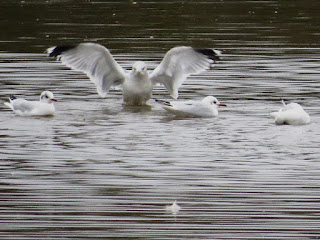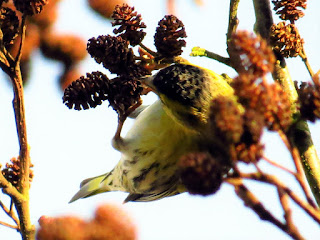Another visit to the public hides at the SOS Reserve of Venus Pool was very rewarding.
One of the earliest returning birds are Shelduck. These all go to the Heligoland Bight in the North Sea to moult and then return to look for breeding sites – often in Rabbit burrows! Here is a drake with the sizeable swelling at the base of the bill.
Shelduck are dabbling ducks, capable of reaching vegetation at some depth!
Shelduck can be confused with the similarly coloured drake Shoveler. Here a sleeping Shelduck and (parts of) seven drake and one duck Shoveler (and a drake Mallard). Shelduck are much bigger!
There were four Shelduck present and at least two were drakes that were none too pleased to see each other.
The weather was too dull to freeze the action but you get the idea!
Most drakes are now in full breeding plumage. A drake (Common) Teal here
And compare and contrast with the drake Shoveler.
A pair of Shoveler doing what they like to do – spinning around each other to stir up food from the bottom to filter the goodies with those strange bills.
Not ideal conditions for photographing flying birds – two drake and one duck Shoveler show their blue forewings, much more pronounced on drakes.
Back they come ... with an additional drake.
Three highlights today: one was this group of Wigeon feeding on the grass and getting closer and closer the longer we stayed in the main public bird-hide.
Here a pair with the duck on the left.
A duck here. The white belly on both sexes aids flight identification of groups.
Food!
A different duck and a quite-different looking bird. The different tone is only partly due to the angle of the light. Note also the white around the eye. Rather a puzzle as I initially assumed the bird was showing its nictating membrane that are used by birds to clean the eye and can be used to protect the eye in flight. This bird looked like this throughout and it only covers part of the eye. So not sure what / why.
And another duck.
Not all drakes had completed their moult – perhaps first-winter birds? The yellow head stripe is beginning to show as are the vermiculations along the flanks.
Another view of the same bird.
A different drake, also still to complete its moult.
Another yet another different drake.
Reminder: a ‘proper’ drake...
... head-on.
And just look at the detail of those long feathers – grey one side, with a white shaft and white-fringed black the other side. The barred feathers are pretty impressive too.
A group of Wigeon takes off. On the right-most bird we can see the yellow crown and the white in the forewing shown by drakes. A good view of the green speculum on the lower middle bird.
Not a melanistic Wigeon but a Coot lurking in with three drakes, the presumed first-winter in the foreground. Rather surprised that there was no aggression between these.
This Coot finds it amusing.
I hope that Lapwings get good reception from their antenna!
And again.
Very subtle colours – sun to gloss the green would have been nice.
A Common Snipe apparently being chased up the bank by a pair of Gadwall. Alert like this it really shows the length of the bill.
Highlight #2 was this adult Common Gull – unusual in this part of Shropshire and my first here for at least five years. With a slightly darker mantle and slightly larger than the accompanying Black-headed Gulls. Note the greeny-yellow bill with, in winter only, a black band; also the pale greeny legs and the dark eye.
“its all very boring here”
Here showing its wing-pattern. The white on the wing-tip is quite different from any Herring Gull-type and is remarkably similar on the underwing making it stand out at long range in flight.
And here we see that underwing pattern.
When I next looked another Common Gull had turned up. Note the slightly different tone in the bill. Note sure why – a second winter bird perhaps, though the white spots in the folded wings would suggest a full adult.
Highlight #3! Around the bird feeders this male Sparrowhawk arrived and stayed amongst the twigs. The rufous barring tells us this is a male. However the barring is less dense than it would be on an adult male and the brown tips on the flight feathers suggest this is in fact a first-year male.
“Are you looking at me?”
It was very alert to all that was going on around it – there were dozens of tits that had ‘forgotten’ it was there. It was looking this way ...
... and that.
A careful reposition in the hide to get a clearer view did not go unnoticed!
They do look fierce! Note the white spots on the back.
This Blue Tit was blissfully unaware of the potential danger.
(Ed Wilson)




























































